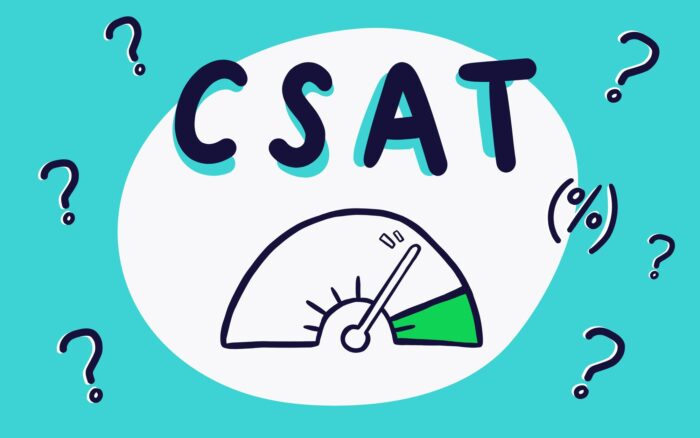
In the bustling realm of commerce, where competition is fierce and customer loyalty is paramount, the significance of Customer Satisfaction (CSAT) cannot be overstated. The pursuit of elevated CSAT scores is not merely an exercise in appeasing customers but an intricate strategy to unlock latent business potential. In this comprehensive exploration, we will delve into a holistic methodology for CSAT enhancement, traversing the realms of client understanding, personalization, proactive communication, transparency, empowered teams, technological integration, feedback solicitation, and the perpetual pursuit of improvement.
Understanding the Customer Journey

The customer journey is not a linear pathway but a complex tapestry of interactions, decisions, and emotions. A meticulous understanding of this intricate web is essential for businesses seeking to elevate CSAT. And while calculating customer satisfaction score is a necessary step, it is only the tip of the iceberg. To truly understand the journey, businesses must adopt various methods. It begins with the initial client touchpoints, extending from product discovery to post-purchase engagement. By scrutinizing and optimizing each juncture, businesses can align their offerings with client expectations at every stage, ensuring a seamless and satisfying journey that naturally boosts CSAT.
To achieve this, invest in robust analytics tools that unravel the nuances of customer behavior. These tools provide invaluable insights into the customer journey, allowing businesses to identify pain points and areas for improvement. This proactive approach transforms the client experience from reactive issue resolution to a pre-emptive strategy that anticipates and addresses needs before they surface.
Personalization: Beyond the Greeting
Personalization has transcended the realm of a simple salutation; it is now a sophisticated strategy that differentiates a brand from its competitors. Beyond addressing customers by their first name, businesses must leverage data analytics to deliver highly tailored experiences. This encompasses personalized marketing messages, product recommendations, and service interactions.
Implementing a robust Customer Relationship Management (CRM) system is integral to achieving this level of personalization. CRM systems aggregate customer data, allowing businesses to craft personalized experiences based on individual preferences, purchase history, and interaction patterns. By demonstrating a nuanced understanding of each client, businesses not only enhance satisfaction but also cultivate a sense of loyalty and affinity.
Proactive Communication for Anticipation

While reactive communication addresses customer queries, proactive communication is the hallmark of a customer-centric approach. Businesses must transcend the conventional customer support paradigm and anticipate needs before customers articulate them. This requires the integration of automation and Artificial Intelligence (AI) tools that can predict potential pain points and provide preemptive solutions.
Proactive communication is particularly impactful during periods of change or uncertainty. Whether it’s a product update, policy change, or service interruption, keeping customers informed in advance fosters a sense of trust and transparency. By demonstrating foresight and a commitment to client welfare, businesses not only enhance CSAT but also fortify their brand image.
Building Trust Through Transparency
Trust is the bedrock of any enduring customer-business relationship. Establishing trust involves transparent communication, especially during pivotal moments such as product launches, pricing adjustments, or policy modifications. When businesses openly communicate changes and provide clear explanations, it not only builds trust but also sets the stage for increased satisfaction.
Transparency should extend beyond external communication to internal practices. Customers appreciate knowing the ethos of the companies they engage with. Share insights into ethical practices, sustainability initiatives, and corporate responsibility. When customers perceive a company as transparent and ethically aligned, it significantly enhances their satisfaction and loyalty.
Empowering Customer Service Teams

Behind every positive CSAT score is an empowered and knowledgeable customer service team. Businesses must invest in continuous training programs that equip their teams with the skills to handle diverse client scenarios. Beyond standard training, fostering a culture of problem-solving and empathy is crucial.
Empowered teams are not confined to resolving issues; they become brand ambassadors capable of turning even challenging situations into opportunities for customer delight. Provide them with the tools and autonomy to make decisions that prioritize client satisfaction. When frontline employees are empowered, it reflects positively in customer interactions, contributing to elevated CSAT scores.
Harnessing Technology for Efficiency
In the era of digital transformation, technology is a powerful ally in the quest for enhanced CSAT. Implementing advanced technologies such as chatbots, AI-driven analytics, and automated feedback systems streamlines processes, reducing response times and enhancing overall efficiency.
Chatbots, for example, can handle routine queries, freeing up human agents to focus on more complex issues. AI-driven analytics not only provide real-time insights but also contribute to predicting customer preferences and trends. Automated feedback systems ensure a consistent and structured approach to gathering customer opinions. Leveraging technology in these ways not only ensures timely customer support but also positions the business at the forefront of innovation.
Soliciting and Utilizing Customer Feedback

Customer feedback is a dynamic reservoir of insights that, when tapped into strategically, can propel businesses toward CSAT excellence. Actively soliciting feedback through various channels, such as surveys, reviews, and social media, is not merely a post-purchase formality but an ongoing dialogue that informs and shapes the customer experience.
Implementing a robust feedback mechanism involves the careful design of surveys that capture both quantitative and qualitative data. Analyzing this data provides a comprehensive understanding of customer sentiments, preferences, and pain points. However, soliciting feedback is just the first step; the true value lies in utilizing this feedback for continuous improvement.
Measuring and Iterating for Continuous Improvement
Achieving high CSAT scores is not a static goal but an ongoing process of refinement and evolution. Establishing key performance indicators (KPIs) to measure CSAT regularly is essential for monitoring progress and identifying areas for improvement. The data collected from customer feedback, surveys, and other metrics should not be viewed in isolation but as a dynamic blueprint for organizational growth.
Continuous improvement involves iterating on existing processes, products, and services based on client insights. This might involve tweaking customer service protocols, refining product features, or optimizing user interfaces. By instilling a culture of continuous improvement, businesses ensure that they not only meet current customer expectations but also stay ahead of evolving preferences, solidifying their position as a customer-centric entity.

This comprehensive exploration has traversed the realms of understanding the customer journey, embracing personalization, fostering proactive communication, building trust through transparency, empowering customer service teams, harnessing technology, soliciting and utilizing customer feedback, and committing to continuous improvement.
By adopting this holistic approach, businesses not only boost their CSAT scores but also cultivate enduring relationships with satisfied and loyal customers. In a landscape where competition is fierce and customer expectations are ever-evolving, CSAT is not merely a metric but the cornerstone of sustainable success. It is the bridge that connects businesses to their clientele, fostering a mutually beneficial relationship that unlocks the full potential of both parties.











